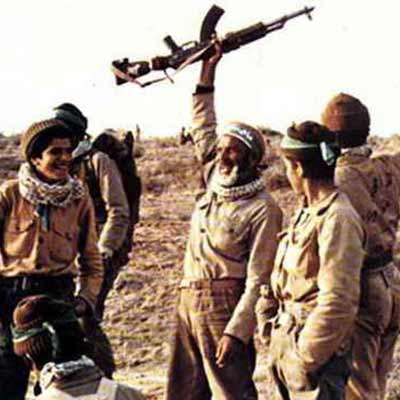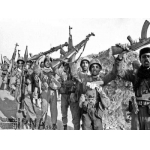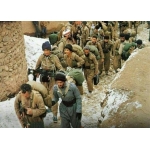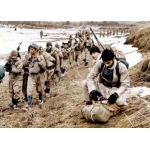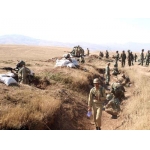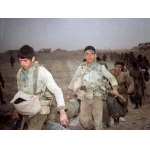Operation Zafar-2
Azamsadat Hosseini
202 بازدید
The forces of the Islamic Revolution Guards Corps' Ramadan Regiment and the Iraqi Kurdish opponents of Saddam designed and executed Operation Zafar-2 in 1987 in Kirkuk, Iraq.
Operation Zafar-2 was implemented in an unconventional manner. The IRGC designed this operation to respond to the chemical bombing and destruction of Kurdish villages in the northern provinces of Iraq. The destruction of military, economic and strategic facilities and centers, and the destruction of Iraq's combat power and military support in this area, were announced as the goals of this operation. The operational area was the city of Kufri. Aqaba was considered the base of the Iraqi armies’ northern front. It was for this reason that the destruction of this city was very important for Iran.[1]
This operation started on October 2, 1987, with the codename of “Labbayk Ya Hussain”. At the beginning of the operation, Iraqi Kurdistan Patriotic Union forces executed an ambush on the Erbil-Sulaymaniyah road, killing two Iraqi forces and capturing nineteen. In this phase, the broadcasting tower of Izmer Radio and Television was also destroyed on the heights overlooking the city of Sulaymaniyah. Furthermore, three cars and a large amount of weapons and ammunition of the Iraqi forces were seized by the Kurdish fighters. To combat the infiltration operations of the Kurdish Peshmerga, the Iraqi army set a daily curfew of 15:00 until morning for private vehicles on these roads, thus preventing traffic. This was done by establishing numerous checkpoints on the roads leading to the city of Sulaymaniyah.[2]
The fighters under the command of the Ramadan Regiment, consisting of the Ground Forces of the Revolutionary Guards and the 9th Badr Division of the Supreme Majlis of the Islamic Revolution of Iraq, in a dynamic maneuver, attacked the headquarters of the battalion and the units located in the important heights of Kufr Dagh. After entering, they dealt major casualties and heavy losses to the Iraqi army. They then captured the Iraqi camps and seized a significant amount of war equipment. This was the beginning of the destruction of the facilities of the city of Kufr.[3]
After suffering 300 killed and wounded, the Iraqi forces tried to prevent the further advance of the Iranian forces, but these efforts failed, resulting in the police and defense bases around the city of Kufri to also come under the control of the Iranian fighters. In the continuation of the operation, the Iranian forces took full control of the important roads of Kufr-Baghdad and Kirkuk-Khanqin-Tikrit. This enabled them to enter the city. By crushing the remaining Iraqi forces, the Iranian forces destroyed the city's military and economic facilities, including the building of the Iraqi Security Organization, the building of the Iraqi Baath Party, the municipality building, the post and telegraph building, the power plant, and a gas station. The governor's building was destroyed after a skirmish and the governor of this city was killed. During this attack, the Rafdin Bank branch and a factory were also destroyed. Among other important centers that were destroyed was the barracks of Jaish al-Shaabi Forces of Iraq. With the continuation of the operation and the cleaning of the important centers of the city, a number of the military and security forces of the city of Kufri were killed and injured, and a number of them fled from Mahleka.[4]
In this operation, Iraq lost quite a bit of military equipment. This equipment consisted of dozens of tanks and personnel carriers, some military vehicles, dozens of medium weapons, twenty social and individual bunkers, five firing positions and twelve ammunition dumps. In the Zafar-2 unconventional operation, Iranian forces managed to seize a large amount of ammunition and light and medium weapons. The number of Iraqis killed and wounded in this operation reached 500. [5]
[1] Habibi, A., Record of Operations of the Islamic Guards in the Eight Years of Sacred Defense, Tehran: Islamic Revolutionary Guard Corps Publications, 2004
[2] Yazdan Pham, M., Journal of the Iran-Iraq War, 50th Book: The Limited War between Iran and the United States in the Persian Gulf, Tehran: Islamic Revolutionary Guard Corps War Studies and Research Center, 2017, p. 228; Samii, Ali, Descriptive record of the operations of Islamic warriors during the eight years of holy defense, Tehran: Representation of the Supreme Leader in the Ground Forces - Deputy of Publicity and Publications, 1997, p. 357.
[3] Samii, A., Descriptive record of the operations of the warriors of Islam during the eight years of holy defense, p. 357.
[4] Habibi, A., The record of operations of the Islamic armies in the eight years of holy defense, p. 186; Samii, A., Descriptive record of the operations of Islamic warriors during the eight years of holy defense, pp. 357 and 358.
[5]Habibi, A., The record of operations of the Islamic armies in the eight years of holy defense, p. 186.


